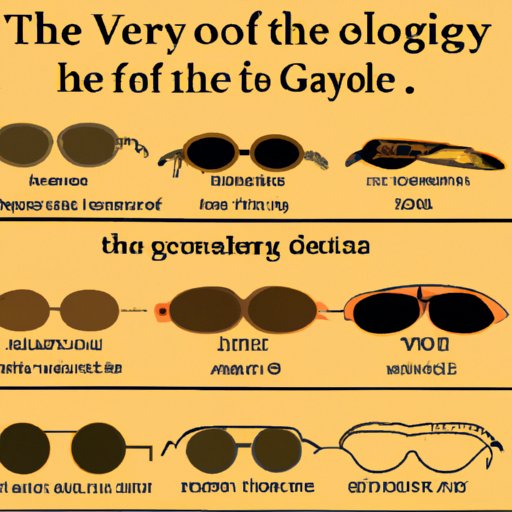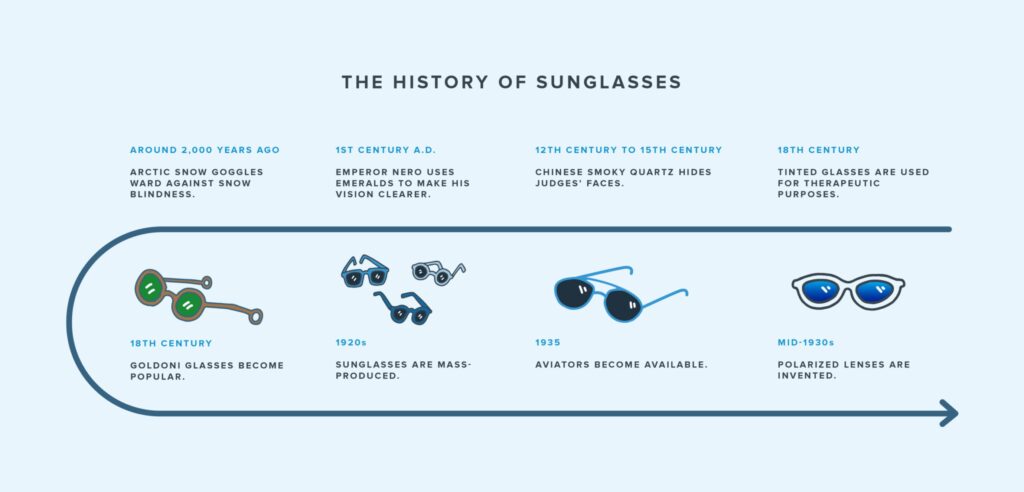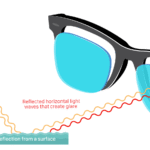Sunglasses. A seemingly simple accessory, yet one that holds a surprisingly rich and complex history. From their humble beginnings as a practical solution to a glaring problem, they have evolved into a ubiquitous fashion statement, a symbol of cool, and even a vital piece of protective equipment. Understanding when sunglasses were invented isn’t simply about pinpointing a date; it’s about tracing the evolution of a technology that has profoundly impacted our relationship with the sun, vision, and style. This journey takes us through centuries of innovation, from rudimentary eye protection crafted from natural materials to the sophisticated, technologically advanced lenses we wear today. This exploration will delve into the historical context, examining the social, cultural, and technological factors that shaped the development of sunglasses. We’ll uncover the inventors, the key advancements, and the surprising paths that led to the ubiquitous eyewear we know and love. The story of sunglasses is more than just about protecting our eyes; it’s a reflection of humanity’s ongoing quest for comfort, style, and protection from the elements.
Early Forms of Eye Protection: Before the “Sunglasses”
Ancient Civilizations and the Need for Shade
The need for eye protection from the sun’s harsh glare is as old as humanity itself. Long before the invention of modern sunglasses, various cultures devised ingenious methods to shield their eyes. Evidence suggests that the Inuit people used snow goggles made from bone, wood, or ivory with narrow slits to reduce glare. These early examples demonstrate a fundamental understanding of the need to protect the eyes from intense sunlight. Similarly, in ancient China, judges wore dark, flat pieces of polished jade or quartz to protect their eyes during court proceedings, demonstrating a connection between status and eye protection. These early forms, while not sunglasses in the modern sense, represent the earliest attempts to mitigate the effects of sunlight on the eyes.

Roman Emperors and the Use of Smoked Quartz
The Romans, known for their advancements in various fields, also contributed to the early history of eye protection. Evidence suggests that Roman emperors and wealthy citizens used slices of smoked quartz to shield their eyes from the intense Mediterranean sun. These rudimentary lenses provided a degree of protection, offering a glimpse into the early desire for enhanced visual comfort. While not mass-produced, these examples highlight the early adoption of a lens-based solution to the problem of glare, a precursor to the functionality of modern sunglasses.
The Evolution of Materials
The materials used for early eye protection reflect the available resources and technological capabilities of each era. From natural materials like bone, wood, and quartz, the evolution of materials eventually led to the use of glass, a significant step towards creating more effective and durable eye protection. This transition laid the groundwork for the eventual mass production of sunglasses.
The Birth of Modern Sunglasses: The 18th and 19th Centuries
Early Glass Lenses and Their Limitations
The 18th and 19th centuries saw the development of more sophisticated lenses. Early glass lenses, while offering better protection than natural materials, were often bulky, heavy, and lacked the optical clarity of modern lenses. These early lenses primarily served practical purposes, such as protecting the eyes from intense light during specific tasks, rather than being fashion accessories. The lack of efficient manufacturing techniques and the limited understanding of optical properties hindered the widespread adoption of these early glass lenses.
The Role of Innovation in Lens Technology
The development of improved glassmaking techniques and a deeper understanding of optics were crucial factors in the progression towards modern sunglasses. The ability to create clearer, thinner, and more durable lenses paved the way for more comfortable and effective eye protection. This period saw the slow transition from purely functional eye protection to something that began to consider aesthetics and comfort.
The Impact of Industrialization
The industrial revolution played a significant role in advancing lens technology. Mass production techniques made it possible to create lenses at a larger scale and at a lower cost, making them more accessible to a wider population. This increased accessibility contributed to the growing popularity of eye protection, setting the stage for the eventual emergence of sunglasses as a fashion item.
The 20th Century: Sunglasses Become Mainstream
The Rise of Sunglasses as Fashion Accessories
The early 20th century witnessed the transformation of sunglasses from purely functional eyewear to a fashion statement. The invention of more sophisticated lens materials, improved manufacturing techniques, and the influence of Hollywood stars contributed to this shift. Sunglasses became a symbol of glamour and sophistication, further boosting their popularity among the general public. The design and style of sunglasses evolved rapidly, reflecting the changing fashion trends of the time.
Technological Advancements in Lens Production
The 20th century also saw significant advancements in lens production technology. The development of new materials, such as plastic, allowed for the creation of lighter, more durable, and more affordable lenses. This technological progress made sunglasses accessible to a broader segment of the population, further solidifying their place in society.
The Impact of Marketing and Popular Culture
The strategic marketing of sunglasses by brands and their prominent placement in movies and popular culture significantly impacted their widespread adoption. Hollywood stars, athletes, and other celebrities frequently wore sunglasses, associating them with glamour, style, and coolness. This association had a profound effect on consumer demand.
Sunglasses Today: A Blend of Function and Fashion
The Diverse Range of Sunglasses Available
Today, the market offers a vast array of sunglasses catering to various needs and preferences. From basic, affordable models to high-end designer pieces, consumers have a wide range of choices in terms of style, functionality, and price. The advancements in lens technology have led to the development of specialized sunglasses designed for specific activities, such as sports, driving, and even specific lighting conditions.
The Importance of UV Protection
Modern sunglasses emphasize the importance of UV protection. UV rays from the sun can damage the eyes, leading to various health problems. Many modern sunglasses incorporate UV-blocking lenses, providing essential protection against the harmful effects of the sun. The understanding of the risks associated with UV exposure has increased the demand for sunglasses with strong UV protection features.
The Future of Sunglasses Technology
The future of sunglasses looks bright, with ongoing innovations in lens technology and design. We can expect to see even more specialized sunglasses, incorporating features such as smart technology, advanced polarization, and enhanced comfort features. The pursuit of better eye protection and improved visual experience will continue to drive innovation in the sunglasses industry.
Summary and Recap
The journey of sunglasses, from rudimentary eye protection in ancient civilizations to the sophisticated eyewear we see today, is a fascinating reflection of human ingenuity and the ever-evolving relationship between technology and fashion. Early forms, crafted from natural materials like bone and quartz, served a purely functional purpose, protecting eyes from harsh sunlight. The development of glass lenses in later centuries represented a significant advancement, but it was the 20th century that witnessed the transformation of sunglasses into a mainstream fashion accessory.
Key advancements included improved glassmaking techniques, the introduction of plastic lenses, and the strategic marketing efforts that cemented sunglasses’ place in popular culture. The influence of Hollywood and celebrity endorsements played a pivotal role in their widespread adoption. Today, sunglasses are not just a fashion statement; they are also a vital piece of protective equipment, with many modern lenses offering superior UV protection. The ongoing development of new technologies promises even more specialized and advanced sunglasses in the years to come.
- Early Forms: Bone goggles, smoked quartz lenses.
- Technological Advancements: Improved glassmaking, plastic lenses, UV protection.
- Cultural Impact: Hollywood, fashion, celebrity endorsements.
- Modern Significance: Fashion, protection, specialized applications.
Frequently Asked Questions (FAQs)
When were the first commercially produced sunglasses made?
While rudimentary forms of eye protection existed for centuries, the first commercially produced sunglasses, featuring mass-produced lenses, emerged in the early to mid-20th century. The exact date is difficult to pinpoint due to the gradual evolution of the technology and the varying definitions of “sunglasses”. However, the widespread availability and marketing of sunglasses significantly increased in the 1920s and 1930s.
Who is considered the inventor of sunglasses?
There isn’t a single inventor of sunglasses. The development of sunglasses was a gradual process involving numerous contributions from various individuals and cultures over centuries. Early forms of eye protection were created by different civilizations independently, and the evolution of lens technology involved multiple advancements by different individuals and companies.
What materials were used in the earliest sunglasses?
The earliest forms of eye protection used readily available natural materials. These included bone, wood, ivory (especially among Inuit peoples), and later, polished slices of naturally occurring materials like smoky quartz, which offered a degree of light filtration.
How did sunglasses evolve from purely functional items to fashion accessories?
The transition of sunglasses from functional items to fashion accessories was a gradual process. Several factors contributed to this transformation, including improved lens technology (making them lighter, more comfortable, and stylish), the influence of Hollywood and celebrities, and strategic marketing efforts by brands. The association of sunglasses with glamour and coolness in popular culture greatly impacted their adoption as a fashion item.
What are the most important features to consider when buying sunglasses today?
When purchasing sunglasses today, it is crucial to prioritize UV protection. Look for lenses that block 99-100% of UVA and UVB rays. Lens quality and comfort are also essential. Consider the type of activity you’ll be using them for (driving, sports, etc.) and choose a style and fit that is comfortable and provides adequate protection.



